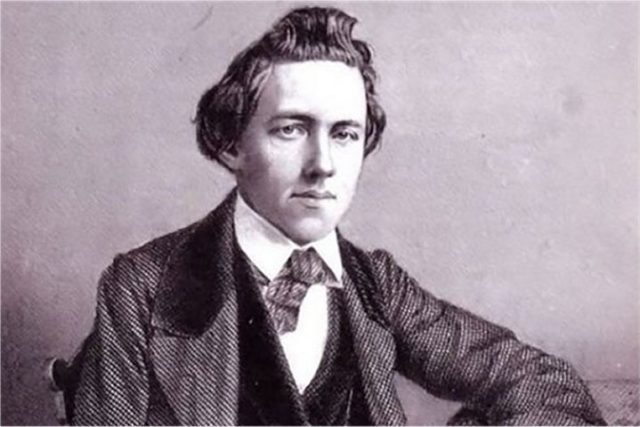In our column Champion Born On This Date, today I have the pleasure of presenting a beautiful game by Paul Morphy. He was a champion who can be called William Shakespeare of Chess.
What ‘all time greats’ said about Paul Morphy?
Bobby Fischer– “He was the most accurate Chess Player” and “He was probably the greatest genius in Chess”.
Garry Kasparov-“He mostly played with zero inaccuracy” and “He is the only player who never made a blunder”.
Adolf Anderssen– “Finest Chess player ever existed”.
Though nothing much has been said about him by the Soviets, most of the Soviet Chess trainers give a lot of emphasis on his way of play. In the famous book Miniatures by World Champions, Anatoly Karpov has dedicated more than one third of the book to the games of this great player.
The period in which Paul Morphy played actively is known as The Golden Era of Chess. This is because, some of the best gems of artistic Chess were created in this era.
Life- Paul Morphy
Paul Charles Morphy was born on 22nd June 1837 at New Orleans in a wealthy family. According to his family sources, Morphy learnt Chess by himself.
By the age of 13, Paul Morphy became famous as the best player in the United States. In 1850s, he visited Europe and defeated the strongest players in the world with ease. As a result, he was acknowledged as the Best Chess Player in the World. The official World Champion titles, however, started much later, in 1886.
Best games played by Paul Morphy
Morphy’s victory over Count Carl Isouard and Duke of Brunswick of France is probably one of the most famous Chess game.
His stunning Rook and Queen sacrifice against the then British Champion Henry Bird finds place in every book on Chess combinations.
Morphy did not talk or write much about Chess but his simple quote “Help your pieces so they can help you” is the best advice a Chess Trainers could give to their pupils. Paul Morphy demonstrated that the safety of King and activity of pieces invariably decide the outcome of a Chess game.
Even today, the time of Paul Morphy is known as The Golden Era of Chess.
Learn from the Champion
Today we will see a comparatively unknown but extremely creative game by Morphy. I was lucky to see it as a child, that too, annotated by master of King side attack, Grandmaster Leonid Shamkovic.
I was indeed greatly impressed by the originality of Morphy’s play then but I must confess that today I stand even more impressed by the game for its planning and execution.
1.e4 e5 2.Nf3 Nc6 3.Bc4 Nf6 4.Ng5
This attack on Black’s f-pawn is a standard procedure of attacking ‘f7’ since the 16th century.
4…d5 5.exd5 Na5!
The classical system of counterattack for Black. Instead of recapturing the pawn at d5, Black goes after the enemy bishop.
6.d3?!
This move allows Black to take the initiative but it was a popular choice at that time.
Better is 6.Bb5+ c6 7.dxc6 bxc6 and here White has three options, 8.Be2 8.Bd3 and 8.Qf3Though White retains the extra Pawn, Black’s lead in development compensates for the sacrificed Pawn.
6…h6
Black drives back the White knight.
7.Nf3 e4! 8.Qe2
8.Nd4?! was dangerous on account of 8…Bc5! as 9.Nb3? allows Bg4! with a powerful initiative to Black.
8.Nfd2 is bad due to 8…Bg4!
8…Nxc4 9.dxc4 Bc5! 10.h3! 10…0–0 11.Nh2 Nh7!?
Black shows a very deep understanding of the position. As he realises that piece play alone will not be enough to break through White’s position, he prepares a ‘Pawn Storm’ by pushing the f-pawn till it is stopped byWhite pieces.
However, modern engines show that more accurate would have been 11…e3! 12.Bxe3 Bxe3 13.fxe3 Ne4 14.Nf1 Qh4+ 15.g3 Qf6!16.c3 Bf5! 17.Nbd2 Nc5!
11…c6! &11…b5! are also in the spirit of the position.
12.Nd2?
12.Be3! was called for.
12…f5!13.Nb3 Bd6! 14.0–0
Trying to castle on the Queen side would have led to catastrophe. For example, 14.Bd2? e3!! 15.fxe3Bg3+ 16.Kd1 Nf6! 17.Be1 Bxh2! 18.Rxh2 b5! 19.Nd4 bxc4 20.Qxc4 Nxd5 21.Nc6 Ba6 22.Nxd8 Bxc423.Nc6 Nxe3+ 24.Kc1 Rae8! 25.Bb4 Rf6 26.Na5 Bd5 27.g3 Nf1 etc.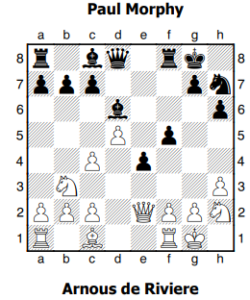
Black to play.
The game went 14…Bxh2+! 15.Kxh2 f4!16.Qxe4 Ng5
The knight enters the game with a gain of tempo on the White Queen.
17.Qd4?
17.Qg6!? was an interesting option. For example, 17…Bf5 18.Qh5 Bxc2 19.Nd4 Bd3 etc.
17.Qd3! was also an alternative leading to a complex unclear position.
The move played — 17.Qd4? –, allows a stunning combination followed by an unexpected finale.
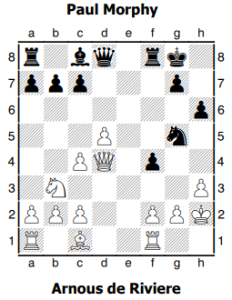 Black to play.
Black to play.
Morphy clinched the issue with 17…Nf3+!!
A beautiful sacrifice which creates decisive light square weakness on White’s King side. Instead, 17…Bxh3? would have allowed White to defend with 18.Bxf4! Bd7 19.Kg1 etc.
18.gxf3 Qh4 19.Rh1!
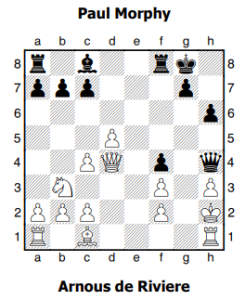 Black to play
Black to play
White seems to have guarded his King side well. The obvious capture 19….Qxh3 check gives White aclear upper hand after 20. Kg1 whereas an attempt to bring the King Rook in play with 19….Rf6 allowsWhite to move the King to safety after 20.Kg2!
However, Morphy had already planned his final assault after the Rook move as well.
19…Bxh3!!
The point! Now the White King has been caught in a cage with no possible escape.
20.Bd2
20.Nc5 leaves the White Queen unguarded and is punished with 20…Rf6! 21.Bxf4 Bf5+! 22.Kg1 Rg6+23.Bg3 Qxd4 etc.
20.Bxf4 Rxf4 21.Qxf4 Qxf4+ 22.Kxh3 Qxf3+ 23.Kh2 Qxf2+ 24.Kh3 Rf8 is equally hopeless for White.
20.Rg1? allows 20….Bf1Checkmate!
- Kg1 allows 20….Qg5 ch, 21. Kh2, Qg2 Checkmate.
Now back to the game. There followed 20…Rf6! 21.Qxf6
Forced. 21.Raf1 leads to an immediate mate after 21…Bf5+ 22.Kg2 Rg6.
21.Nc5 trying to bring the Knight for defence is too slow. Black plays 21….Rg6! followed by a Bishop move with a deadlydiscovered check by the Queen.
21.Qd3 (to stop ….Rg6) allows a similar finish as in the game. 21…Qxf2+! 22.Kxh3 Qg3#
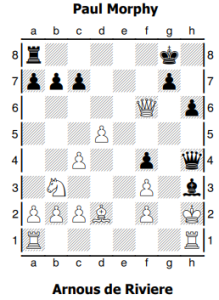 Black to play.
Black to play.
Instead of capturing the White Queen, Black won brilliantly with 21…Qxf2+! 22.Kxh3 Qg3 Checkmate!

